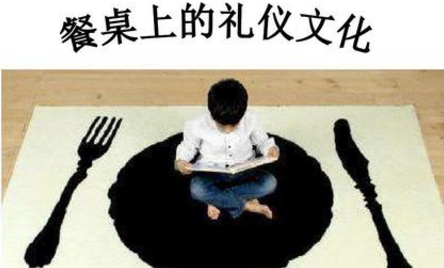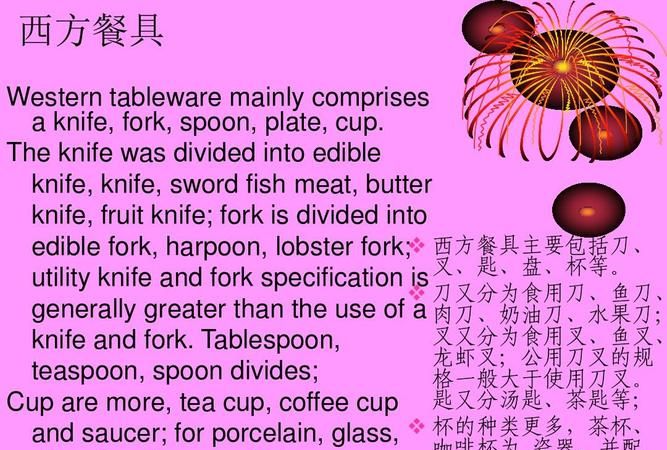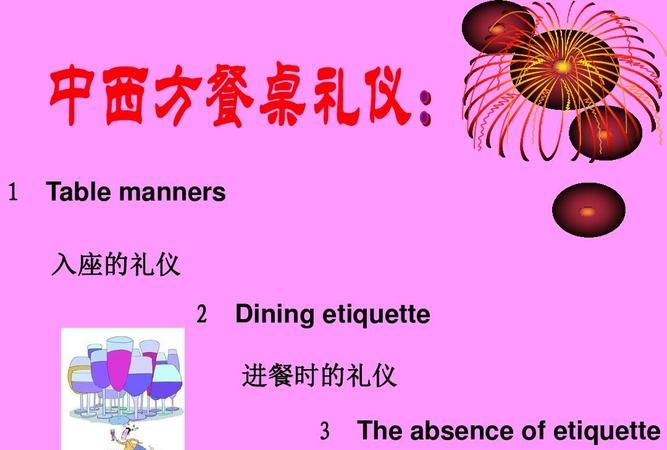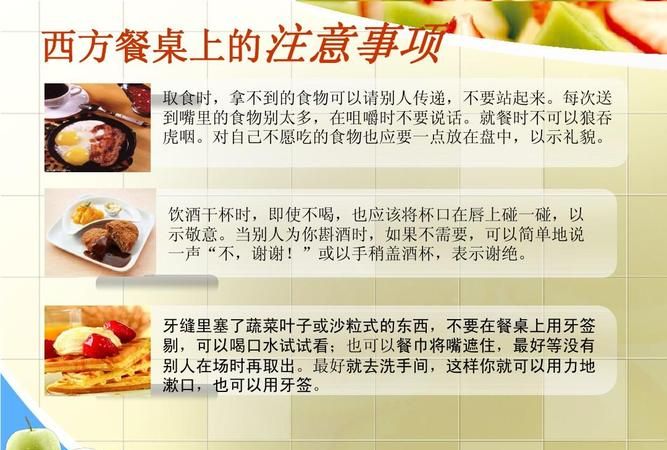本文目录
十条中国餐桌礼仪英文
1、When helping a woman pull her chair to the table, hold it and guide it. Don’t shove it against the back of her legs.
为女士拉椅子的时候,要把椅子抓住了,留个角度,让女士好走过去。别让椅子腿碰到女士的腿。
2、 If you’re seated at a table with eight or fewer guests, wait for everyone to be served and for the hostess to begin eating before you dig in. At a long banquet table, it’s OK to start when several people are seated and served.
如果就餐人数少于等于八人,那就等所有人都坐好了,女主人开始用餐了,再开动。如果是长餐桌,那么只要有几个人入座进食了,你也就可以开始吃了。
3、All things not having to do with food should remain off the table: keys, clutch bags, cigarette packs, sunglasses, BlackBerrys.
一切和食物无关的东西都不应该出现在餐桌上,包括:钥匙、手袋、烟盒、墨镜还有手机。
4、 Don’t snap your napkin open or unfurl it showily like it’s an Olympic flag.
不要把餐巾展开,看起来像是在展示奥林匹克会旗一样。
5、If you prefer not to have wine while dining out, don’t turn your glass upside down, and don’t make a big deal of saying you don’t drink. Simply place your fingertips on the rim of the glass and say “Not today, thanks.”
如果在用餐时你不想饮酒,不要把酒杯倒过来放,也不要很在意地宣布你不喝酒。只要轻轻地把指尖放在酒杯边缘,说一句“今天不喝,谢谢。”
6、 If you’re eating and want to take a sip, dab your mouth with your napkin to avoid staining the rim of the glass.
如果你在吃东西的时候,想要啜一口饮料的话,那就先拿餐巾把嘴擦干净了,以免在杯子边缘留下残迹。
7、Grabbing a bowl of salad or a saltshaker as it’s being passed to someone who asked for it is the equivalent of cutting in line: greedy and rude.
把原本要递给别人的沙拉碗或者盐瓶从半道截下来,这基本上就等于在说:你是个既贪婪又粗鲁的人。
8、 On the subject of passing: Dishes go counterclockwise, but if someone to your left asks for something, you can hand it directly to him.
餐桌上要传递东西的话,规则一般是逆时针传递。不过,如果坐在你左手边的人想要什么东西时,你也可以直接递给他。
9When you excuse yourself to go to the restroom, just say “Please excuse me.”
想去洗手间的时候,只要说“失陪一下”就可以了。
10、When out with friends or family — even at a fancy restaurant — it’s OK to ask for your leftovers to be wrapped. But don’t do it at a business lunch or dinner.
和朋友家人一起外出用餐,即使是到很高级的餐馆,也可以要求把吃剩下的食物打包带走。不过,如果是在商务宴会上,就不要这么做了。

扩展资料
西餐的餐桌礼仪文化:
1、女士优先。在排定西餐座次时,主位请女主人就座,而男主人位居第二位。
2、以右为尊。在排定座次时,以右为尊。
3、面门为上。面对正门者为上座,背对正门者为下座。
4、交叉排列。男女交叉排列,生人与熟人交叉排列。.
5、美国餐桌礼仪从入座,拿取餐巾、开动、取用餐具、离席,皆有自成一套的规矩,而其中座次与餐具安排,主人会于餐前准备妥当,无需费心。但应熟悉餐具使用顺序及位置功能,以免拿错。
6、女主人宣布晚宴就绪后,男主人引领着客人依次入座,而女主人则走在最后面。有些细心的主人尚会在餐桌上放置姓名卡,以表示座次,若没有此项安排,则其原则如下
7、座次安排以男女分隔而坐为原则。男主客优先入坐,其位置在女主人右边,而女主客则在男主人右边。其他夫妇则以对角方式而坐。男女夫妇分坐显示出美式宴会之开放与活泼,期望借由宴席上座次的安排,增进彼此间之熟稔,并使用餐话题多样化,气氛和乐
8、入座原则系客先入座,长者较年轻者先入座,已婚较未婚先入座,陌生人较熟识客人或家人先入座。
参考资料来源:人民网 - 吃西餐讲究多 西方餐桌礼仪知多少
现在我来告诉你一些中国的餐桌礼仪英语
China Dining Custom
Table Manners
The main difference between Chinese and western eating habits is that unlike the West, where everyone has their own plate of food, in China the dishes are placed on the table and everybody shares. If you are being treated by a Chinese host, be prepared for a ton of food. Chinese are very proud of their culture of cuisine and will do their best to show their hospitality.
And sometimes the Chinese host use their chopsticks to put food in your bowl or plate. This is a sign of politeness. The appropriate thing to do would be to eat the whatever-it-is and say how yummy it is. If you feel uncomfortable with this, you can just say a polite thank you and leave the food there.
Eating No-no's
Don't stick your chopsticks upright in the rice bowl.Instead,lay them on your dish. The reason for this is that when somebody dies,the shrine to them contains a bowl of sand or rice with two sticks of incense stuck upright in it. So if you stick your chopsticks in the rice bowl, it looks like this shrine and is equivalent to wishing death upon a person at the table!
Make sure the spout of the teapot is not facing anyone. It is impolite to set the teapot down where the spout is facing towards somebody. The spout should always be directed to where nobody is sitting, usually just outward from the table.
Don't tap on your bowl with your chopsticks.Beggars tap on their bowls, so this is not polite.Also, when the food is coming too slow in a restarant, people will tap their bowls. If you are in someone's home,it is like insulting the cook.
Drinking
Gan Bei! (Cheers! “Gan Bei” literally means “dry [the] glass”) Besides beer, the official Chinese alcoholic beverage is Bai Jiu,high-proof Chinese liquor made from assorted grains. There are varying degrees of Bai Jiu. The Beijing favorite is called Er Guo Tou, which is a whopping 56% alcohol. More expensive are Maotai and Wuliangye.
-
-
- -
--------------------------------------------------------------------------
Of course, the main difference on the Chinese dinner table is chopsticks instead of knife and fork, but that’s only superficial. Besides, in decent restaurants, you can always ask for a pair of knife and fork, if you find the chopsticks not helpful enough. The real difference is that in the West, you have your own plate of food, while in China the dishes are placed on the table and everyone shares. If you are being treated to a formal dinner and particularly if the host thinks you’re in the country for the first time, he will do the best to give you a taste of many different types of dishes.
The meal usually begins with a set of at least four cold dishes, to be followed by the main courses of hot meat and vegetable dishes. Soup then will be served (unless in Guangdong style restaurants) to be followed by staple food ranging from rice, noodles to dumplings. If you wish to have your rice to go with other dishes, you should say so in good time, for most of the Chinese choose to have the staple food at last or have none of them at all.
Perhaps one of the things that surprises a Western visitor most is that some of the Chinese hosts like to put food into the plates of their guests. In formal dinners, there are always “public” chopsticks and spoons for this purpose, but some hosts may use their own chopsticks. This is a sign of genuine friendship and politeness. It is always polite to eat the food. If you do not eat it, just leave the food in the plate.
People in China tend to over-order food, for they will find it embarrassing if all the food is consumed. When you have had enough, just say so. Or you will always overeat!

关于中国餐桌礼仪的英语作文初二
不清楚你的详细要求,这个是详细版本,可以自行缩减
Generally, Chinese table manners are more informal than the West, although there are more rules concerning interactions with other guests due to high levels of social interaction as a result of the communal style of serving.
Chopstick usage
Chopsticks should always be held correctly, i.e. between the thumb and first two fingers of the right hand.
When not in use, chopsticks must always be placed neatly on the table with two sticks lying tidily next to each other at both ends. Never point the chopsticks at another person. This amounts to insulting that person and is a major faux pas.
Never wave your chopsticks around as if they were an extension of your hand gestures.
Never bang chopsticks like drumsticks. This is akin to telling others at the table you are a beggar.
Never suck the chopsticks.
Decide what to pick up before reaching with chopsticks, instead of hovering them over or rummaging through dishes.
To keep chopsticks off the table, they can be rested horizontally on one's plate or bowl; a chopstick rest (commonly found in restaurants) can also be used.
When picking up a piece of food, never use the tips of your chopsticks to penetrate the food as with a fork; exceptions include tearing apart larger items such as vegetables. In more informal settings, smaller items or those more difficult to pick up such as cherry tomatoes or fishballs may be stabbed, but this is frowned upon by traditionalists.
Never stab chopsticks vertically into a bowl of rice, as this resembles incense sticks used at temples to pay respects to the deceased. This is considered the ultimate dinner table faux pas.
Communal chopsticks
When there are communal chopsticks, it is considered impolite to use your own chopsticks to pick up the food from the shared plate, or to eat using the communal chopsticks.
It is considered impolite to use the blunt end of one's own chopsticks to transfer food from a common dish to one's own plate or bowl; use the communal chopsticks instead.
When communal chopsticks are not provided, it is considered polite (and sanitary) to use the blunt end of one's own chopsticks to serve a guest by transferring food from the common dish to a guest's plate or bowl.
An exception to the above can usually be made in intimate settings such as at home.
Other utensils
If noodle soup is served, many consider a more elegant way to eat by picking the noodle into a serving spoon first, and eating from the spoon, rather than slurping directly from the bowl into the mouth using chopsticks.
Chinese traditionally eat rice from a small bowl held in the left hand, however by no means is this good etiquette. It is believed this is the way most people eat but not at all an indication of how it should be done. The rice bowl is raised to the mouth and the rice pushed into the mouth using the chopsticks. Some Chinese find it offensive to scoop rice from the bowl using a spoon. If rice is served on a plate, as is more common in the West, it is acceptable and more practical to eat it with a fork or spoon. The thumb must always be above the edge of the bowl.
Eating from common dishes
Pick the food on the dish that is at the top and nearest to you in distance. Never rummage through the dish or pick from the far side for your favorite food.
In general, more conservative Chinese frown upon the practice of picking more than one or two bites of food in your bowl or serving plate as if you were eating in the Western way. Most Chinese would understand the practice during infectious disease epidemics, or if the person is from the West.
If both a serving bowl - separate from rice bowl - and plate are provided, never put any food items to be eaten onto the serving plate. This rule may be relaxed for foreigners.
If a dish is soupy, pull the serving bowl near the serving dish and reduce the distance the chopsticks need carrying the food. Spilling plenty of sauce on the table is a major faux pas.
After you have picked up a food item, do not put it back in the dish.
Seniority and guests at the table
The elderly or guest(s) of honour are usually the first to start the meal.
The youngest or least senior may serve the eldest or most senior first, as part of the Confucian value of respecting seniors.
The youngest on the table addresses all of the elder members at the table before starting, perhaps telling them to please "eat rice" as a signal to help themselves.
The best food in a dish should be left to the elderly, children, or the guest of honour, even if they are one's favourite.
The eldest person present, or the guest of honour, is given a seat facing the door.
When the hostess says her food is not good enough, the guest must disagree and tell her it is one of the finest foods they have ever tasted.
Drinks
The host should always make sure everyone's cups are not empty for long. One should not pour for oneself, but if thirsty should first offer to pour for a neighbor. When your drink is being poured, you should say "thank you", and/or tap your index and middle finger on the table to show appreciation, especially when you are in Southern China, e.g. Guangdong Province. This action is evocative of bowing your head.
When people wish to clink drinks together in the form of a cheer, it is important to observe that younger members should clink the rim of their glass below the rim of an elder's to show respect.
Strong alcohol, called baijiu, is often served throughout the meal; and it is customary for the host[s]/hostess[es] to insist that guests drink to "show friendship." If the guests prefers not to drink, they may say, "I'm unable to drink, but thank you." [in Mandarin: "Wo bu neng he jiu, xie xie."] The host may continue to insist that the guests drink, and the guests may likewise continue to insist upon being "unable" to drink. The host's insistance is to show generosity. Therefore, refusal by the guests should be made with utmost politeness. Beware: If a guest drinks alcohol with a subordinate at the table, the guest will be expected [if not forced] to drink a glass of the same alcohol with each superior at that table, and possibly at other tables too—if the guest has not passed out yet.
Smoking
Smoking is an extremely prevalent habit in China, especially among men. During meals, the host will sometimes pass out cigarettes to all the men around the table. If a guest prefers not to smoke, she/he should politely refuse. In Mandarin, one could say, "我不抽烟,谢谢" (Wo bu chou yan, xie xie).
Business meals
During business meals, it is best not to eat to the point of satiation, as business and not food is the actual main purpose of the gathering.
Miscellaneous
In the past, some people tended to sit at least 1 metre (3 chi) from the dining table so they would not be literally rubbing elbows with other guests. Nowadays, this practice is rarely observed.
When eating food that contains bones, it is common for the bones be spat out onto the table next to one's plate. Spitting bones onto the floor is almost never acceptable.
Belching, smacking, and slurping are common.
By Western standards, the conversations during meals often are quite loud and animated.
Treatment of staff at restaurants is somewhat "rough," with waiters/waitresses often being advised by patrons to 快点 (kuai dian), which means "hurry up."
Talking with a full mouth and eating with the elbows on the table are both very common, and tasting food from a table guest's plate is also not uncommon.

用英语表达中国的餐桌礼仪
中国餐桌礼仪
Chinese table manners

以上就是关于中国餐桌礼仪英语0句 ,十条中国餐桌礼仪英文的全部内容,以及中国餐桌礼仪英语10句 的相关内容,希望能够帮到您。

